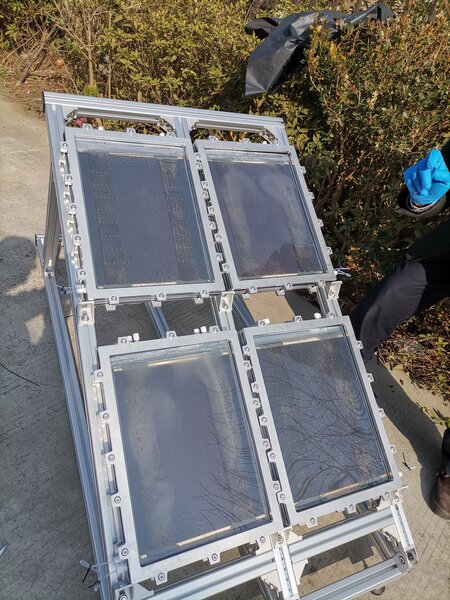
The SunHydrogen Panel encases multiple hydrogen generators immersed in water.
It is made up of several major components. The hydrogen generator forms the core of the technology and is comprised of a substrate with protective layers and ion-transport channels. The substrate serves as the foundation upon which billions of nanoparticles are electroplated and protected from corrosion. The ion transport channels in the substrates are designed to prevent hydrogen and oxygen from mixing, ensuring safe and high-purity production of hydrogen and oxygen.
Nanoparticle-based semiconducting photovoltaic layers harvest energy from sunlight to generate necessary photovoltages and photocurrents.
Oxidation/reduction catalysts use this voltage and current to split water molecules into hydrogen and oxygen.
The device housing encases one or multiple arrays of hydrogen generators with necessary optical windows and piping for continuous collection of hydrogen and oxygen.
The company has successfully validated the manufacturability of its substrates at both the 25cm² and 100 cm² scale, working closely with its industrial partners including Geomatec, a leading manufacturer specialising in thin-film technology; InRedox, an expert in electrochemically-assisted, self-organised nanostructured materials; and its dedicated team at the University of Iowa. Building on this accomplishment, SunHydrogen’s ongoing work is focused on scaling up the production process to meet the substrate requirements for a 1m² SunHydrogen Panel. The 1m² scale is of the utmost importance as it represents the commercially-relevant dimension at which the company intends to introduce and showcase its technology in multiple pilot projects.
Located in the core of the hydrogen generator are two semiconductors configured in a dual-junction setup, designed to harness photovoltage and photocurrents crucial for the autonomous splitting of water molecules.
When integrated in this dual-junction setup, the semiconductor units consistently attain photovoltages of 1.8 volts at the 100 cm² scale, surpassing the required photovoltage for water-splitting by 1.5 times. This accomplishment ensures optimal performance and efficiency, even in the face of potential voltage losses. Additionally, the company has also demonstrated single-junction photocurrent densities of 18 milliamps per square centimetre.
Further, its Iowa team, working in conjunction with the National Renewable Energy Lab, has spearheaded the development of innovative design alternatives for producing a dual-junction hydrogen generator device that could potentially operate at a 10 percent solar-to-hydrogen efficiency. This design can seamlessly integrate into existing photovoltaic production platforms, allowing for reduced module cost and fewer barriers to scale-up.
While the company’s past communications have highlighted its ambition to reach even higher efficiencies, the company believes it is important to emphasise that achieving a 10 percent solar-to-hydrogen efficiency using commercially-proven, inexpensive semiconductor materials sets the company apart from existing solutions and marks a significant milestone.
To put this progress in perspective, a hydrogen panel installation operating at 10 percent solar-to-hydrogen efficiency on one football field would have the potential to generate approximately 40 metric tons of hydrogen annually.
The company’s recent accomplishments position it to scale our technology to a 1m² hydrogen panel with COTEC Corp., its industrial partner in Korea.
The company is parallelly working to increase its solar-to-hydrogen efficiency with the Project NanoPEC team in Germany and with the University of Iowa.
Led by Dr. Nirala Singh, the University of Michigan team is playing a crucial role in SunHydrogen’s efforts to optimise and test potential catalysts for hydrogen and oxygen evolution. The catalysts synthesised by the team operate efficiently for hydrogen production, and the team is working to improve their stability.
The collaboration has also yielded exciting progress in the exploration of potential membraneless operation of the company’s technology. This innovation has the potential to generate substantial savings of up to 8-10 percent in panel costs.
SunHydrogen is currently consulting with world-leading experts to develop innovative reactor designs and system layouts that minimise the overall levelised cost of hydrogen. The company anticipates finalising these designs in early 2024, paving the way for the deployment of pilot scale projects that showcase the world's first wireless green hydrogen production using cost-effective semiconductors.
For additional information:

